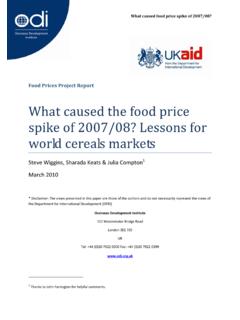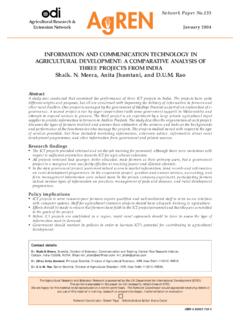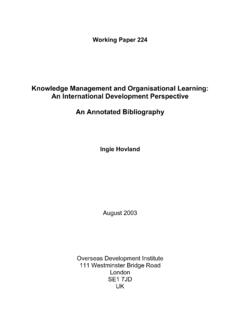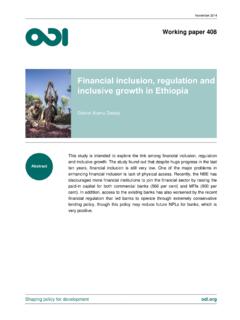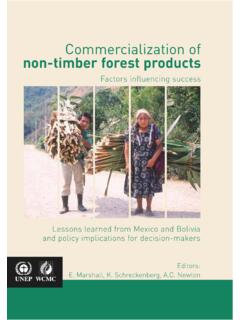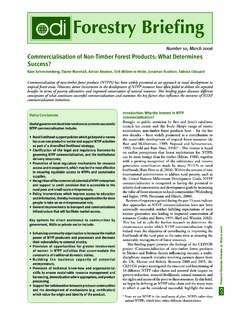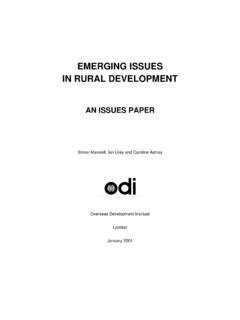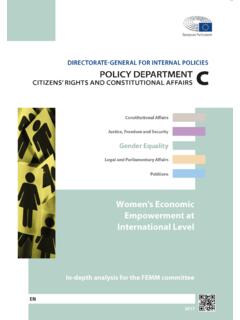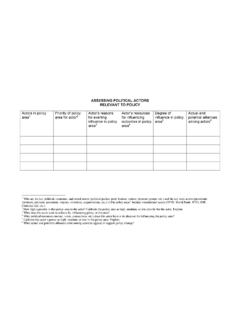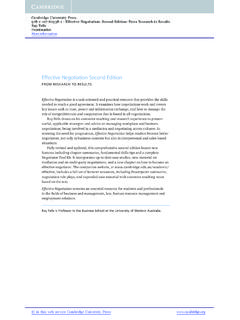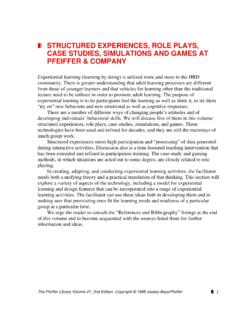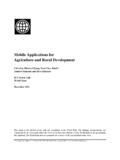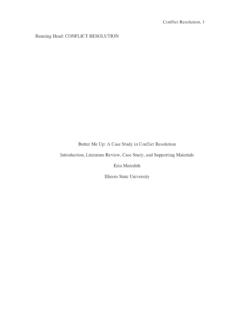Transcription of Working Paper ZIMBABWE CASE STUDY ON TRADE NEGOTIATIONS
1 Working PaperZIMBABWE case STUDY ON TRADE NEGOTIATIONSR ichard HessOctober 2001 Overseas Development Institute111 Westminster Bridge RoadLondon SE1 7 JDUK2 ISBN 0085003 565 1 Overseas Development Institute 2001 All rights reserved. No part of this publication may be reproduced, stored in a retrievalsystem, or transmitted in any form or by any means, electronic, mechanical, photocopying,recording or otherwise, without the prior permission of the .. 5 Acronyms .. 61. ZIMBABWE Background .. ZIMBABWE s economic structure7 Agriculture7 Manufacturing7 Mining7 Transport and Communications8 The Financial Sector8 Current TRADE Time series TRADE and investment data12 Exports13 Export products14 Export markets15 Imports16By product16By Overview of existing TRADE agreements21 World TRADE Organization21 ACP/EU Partnership Agreement22 Common Market for Eastern and Southern Africa23 Southern African Development Community (SADC)24 ZIMBABWE /South Africa Bilateral Agreement25 ZIMBABWE Bilateral Agreements with Botswana, Malawi and Namibia272.
2 TRADE NEGOTIATIONS in the Last 10 Years .. Key issues and interests29 GATT/WTO29 Lom Convention30 Regional agreements31 Bilateral Formation and composition of negotiating Consultation and lobbying Negotiation positions and ZIMBABWE s actual participation in the Outcome of the negotiations373. Lessons Learned .. 39 References .. 41 TablesTable 1: Selected development indicators for ZIMBABWE , together with equivalent values forAfrica as a whole and globally..9 Table 2: Gross capital formation by industry at current prices, US$ Million ..19 Table 3: Investment summary, US$ Million 1996-1998 ..20 Table 4: ZIMBABWE s obligations under different agreements ..385 AcknowledgementsI am grateful to the Department of International Development, UK, for financing this Paper forms part of the Effective Participation by developing Countries in InternationalGovernance, Institutions and NEGOTIATIONS STUDY which is in turn part of the Globalisation andPoverty programme, which now includes fourteen projects on the relationship between theglobal economy, and global institutions, and poverty, and on how the developing countriescan influence this.
3 For further information on this project, please contact Sheila For further information on the Globalisation and Poverty Programme,see or email Common Market for Eastern and Southern AfricaDFID Department for International Development, UKEDFE uropean Development FundESAPE conomic Structural Adjustment ProgrammeFTAFree TRADE AreaGATTG eneral Agreement on Tariffs and TradeLDCsLess Developed CountriesLMGLike Minded GroupNECF National Economic Consultation ForumNRZThe National Railways of ZimbabwePTAP referred TRADE AreaPTC Post and Telecommunications CorporationSADCS outhern Africa Development CommunitySAPS tructural Adjustment ProgrammeSEATINIS outhern and Eastern TRADE and Information InitiativeSPAS pecial Programme of ActionTERCT rade and Economic Relations CommitteeTRIPST rade Related Intellectual RightsUNCTADU nited Nations Council for TRADE and DevelopmentUNDPU nited Nations Development ProgrammeWTOW orld TRADE OrganisationZIMPRESTZ imbabwe Programme for Economic and Structural Transition71.
4 ZIMBABWE ZIMBABWE s economic structureZimbabwe has one of the most diversified economic structures within Africa. This diversityimpacts on the extent of issues with which ZIMBABWE needs to be concerned in internationaltrade NEGOTIATIONS . In turn this calls for a heavier involvement in such NEGOTIATIONS than wouldbe required by many other less diversified developing economies. While it has the secondstrongest economy after South Africa within southern Africa, it is relatively very small incomparison. ZIMBABWE has enjoyed a good reputation by developing country standards;however, recent developments in the economy have undermined that most important sector within the economy is Agriculture, followed by mining,manufacturing and agricultural sector is the most important revenue earner for the country. Althoughagriculture encompasses no more than 15% of GDP, it is responsible for 40% of total exportearnings.
5 It is also the largest employment sector, with 74% of the labour force accrued withinthis sector. As such, it is not difficult to see that the current land redistribution exercise, if itcontinues on its current basis could place the whole economy in jeopardy. The most importantcommodities in terms of revenue generation are tobacco, maize and cotton. AlthoughZimbabwe had to import food commodities during the 1982, 1987 and 1992 droughts, upuntil the current land redistribution exercise it was the largest net food exporter within theregion and was fully able to meet its own food requirements under normal manufacturing sector is one of the largest and most diversified sub-sectors in sub-Saharan Africa, and has traditionally accounted for roughly a quarter of GDP. Zimbabweanindustry is to a large extent a captive market where small companies produce a modest part ofthe total production.
6 There has been a strong history of market collusion among majorproducers and price setting that has resulted in a business culture unconcerned with efficiencyand competitiveness. This culture has been reinforced by Government and parastatalmonopolies in a number of key sub-sectors. This sector has declined significantly in recentyears, primarily due to the policies adopted by Government regarding macro economic policyand the land issue. This sector has been badly affected by down turn in the economy in recentyears and the major restructuring that is currently taking place in the sector. Many companiesface closure and the pressure on wage increases and price freezes will cause this situation toworsen. The current shortage of foreign currency has affected this sector badly and willcontinue to do so for the foreseeable mining sector is a major foreign exchange earner for the country.
7 Over 90% of itsproduction is exported, most of it in crude commodity form. The potential for semi-finished8to finished goods production in this sector is enormous. ZIMBABWE has relatively rich mineraldeposits. Mining accounts for 45% of the country's foreign earnings yet only 9% of and nickel have accounted for over half the value of mining output in the last ten is the largest producer of gold in Africa after South Africa and Ghana. Other majorminerals are asbestos, coal, copper, chrome, iron, tin, silver, phosphate, limestone, cobalt,lithium and platinum. The lowering of mineral prices in world markets and the down turn inthe Zimbabwean economy, combined with the foreign exchange shortage and the fixedexchange rate, have adversely affected the sector. All companies in this sector arerestructuring and attempting to reduce costs in order to survive the changes, some will faceclosure and this will have a major effect on the economy and CommunicationsThe transport and communications sector is one of the fastest growing sectors in theZimbabwean economy.
8 Telecommunication services, provided by the state-owned Post andTelecommunications Corporation (PTC), remain notoriously bad. This remains a seriousobstacle to investment and expansion. However with the advent of the cellular telephonenetworks this has been partly resolved. Nevertheless, the services provided are sometimesunreliable due to poor reception, maintenance and transport infrastructure is good by regional standards, with good roads servicing all majorcities and towns within the country. ZIMBABWE has an excellent road network of over 17,000kilometres of surfaced roads and 19,000 kilometres of un-surfaced roads. However, becauseof excessive spending in the recurrent budget, at the expense of capital investment, the roadnetwork is in danger of serious deterioration. The National Railways of ZIMBABWE (NRZ)once operated one of the most efficient rail systems in sub-Saharan Africa; however in recentyears this has declined significantly and this is causing problems with importation of rawmaterials and with general transportation in the country.
9 Air transport is carried out by AirZimbabwe, the national airline, and a number of freight airlines, providing regularlyscheduled links to major regional centres, as well as providing an air transport system withinthe country. The efficiency of the air transport system has deteriorated significantly over thepast two years with a number of major carriers refusing to come to ZIMBABWE because offears over the standards of safety and problems with the supply of fuel, as well as lack Financial SectorIn terms of market share of the financial sector, commercial banks are the strongest players inthe financial sector ( ), followed by building societies ( ), whilst finance houseshave the smallest market share ( ). There has been considerable reform in the financialsector in recent years, which has resulted in increased market competition as differentinstitutions can now enter markets that were previously barred to them due to , the sector has been subject to a number of problems starting in 1998 with thecollapse of one merchant bank and the ongoing fall out resulting.
10 Combined with thechanging economic situation and the sector s vulnerability to farmers as a result of theuncertainty over the land reform programme this sector is increasingly likely to situationTable 1: Selected development indicators for ZIMBABWE , together with equivalent valuesfor Africa as a whole and sizemillions of people1999126425,975 Population densitypeople per km21999312746 Average annual population growth rate% population% of total19802223401999353446 Gross National Product109 US$ , per capitaUS$19995205004,890 GNP per capita (measured at PPP)US$19992,4701,4506,490 Gross Domestic Product106 US$19908,784297,397 21,390,644 Average annual growth in GDP% annual growth in gross domesticinvestment% private capital flows106 US$1990851,283-1998-2173,452-Foreign direct investment106 US$1990-12834193,38219987644,364619,258 External debt106 US$19903,247176,873-19984,716230,132-Off icial development assistanceUS$ per capita1990353613199824219 National poverty line (1990-91)
